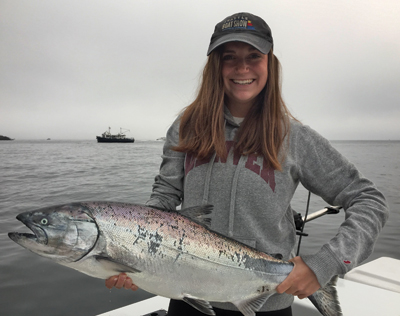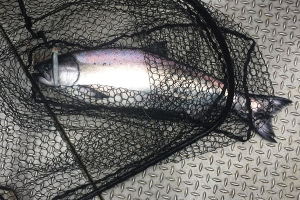Brothers and sisters, we’re ready to fish! June is a great time to kick off the festivities. It’s been a long winter, so time to get that boat ready and get some seafood groceries. As always, please research the state and provincial regulations before you hit the water. You don’t want to get slapped with a ticket to start the summer. I did that when I was 14 years old, riding my dirt bike to work in the Eastern Washington hay fields one sunny June morning many moons ago. The sheriff got a good laugh about me bucking bales for the next few days to pay the ticket. He could have written me up for a lot more than he did, however. The good old days.

But here and now, we may have some halibut opportunities in Washington, but this is usually the month when folks head north for extended trips in British Columbia and Alaska.
Halibut, lingcod, rockfish, and salmon are the big draws. Consider running your own boat up or booking with a lodge. A week reeling in fish amid some of the most beautiful scenery on the planet is not a bad way to kick off the warm season.
Washington will have some salmon fishing open the later part of June. Rockfish can also be had in some coastal areas and it’s really a good time to go after the lingcod in the Northwest. In the interior salt waters, fishing may be regulated to depths shallower than 120’ of water. Bouncing lead head jigs with curly tailed plastics can be lights out. Find a drop off with some kelp and jig your offering from 30’ to 120’ downhill.
Make sure to drift from shallow to deeper water or you will hang up. Cod will also take bait in this manner. In places like the San Juans, there is a size limit of 26” to 36”. This lets the big breeder female fish grow and keep producing babies. Out on the coast there aren’t the same restrictions.
Cod fishing is often done in very deep water with heavy pipe jigs. It’s a run out to the grounds, but it can be well worth it. It’s an interesting difference in habitat between the inshore ling and their rocky haunts and the offshore bank and flats dwellers.
There’s always the possibility that albacore tuna will show up in June. It’s been a bit slower the last couple years for June tuna but that can change anytime. The bite can turn on as the fish show up further south. If your own boat isn’t set up for tuna, consider booking a trip with a charter boat. Going with an experienced tuna captain is a great way to learn the ropes and get some longfins. Larger boats with overnight capacity are available, or try one of the smaller, faster six-pack day boats. The tuna are a real blast to fight and great eating. Canned albacore you caught yourself, flavored to taste, and put up on your own is the best around. Fresh tuna sashimi with soy and wasabi isn’t bad either.
When it comes to finding tuna, it’s useful to keep in mind the sea surface temperature. Tuna are considered warm-blooded because they regulate their body temperature thanks to a process known as counter-current blood exchange. They hang out in warm waters where they spend less energy maintaining their internal furnaces, but feed in the productive cold waters. If you can find that temperature edge between hot and cold, you’re probably going to land right on top of ‘em. Science!
Last, but not least, prawns rock on, especially in the San Juans! Marine Area 7 West has been open a longer duration in the spring and summer for the last few years. With longer open seasons, we see fairly heavy pressure when the season first opens, and then a sharp decrease. License holders go out and get their fill of prawns, and then maybe go out a couple more times when they want a fresh feast. This longer opening really makes sense. With shorter seasons, folks go out in bad weather and strong tides to get what they can, when they can. This makes for a dangerous situation.
Next month is the time for Chinook salmon in the salt waters of the Northwest. We will cover where to find them, how to catch them, and the best way to prepare them for an awesome summer treat. As always, we will go get some!
